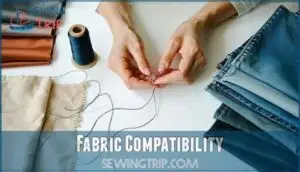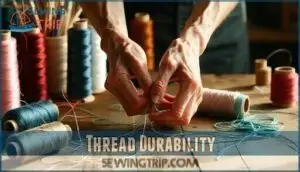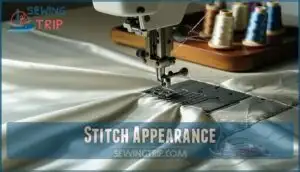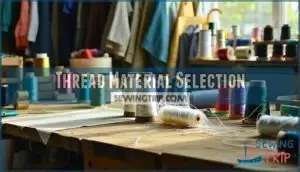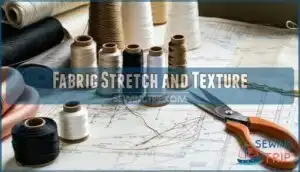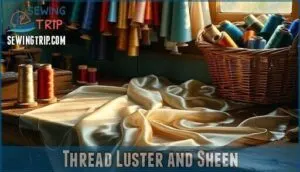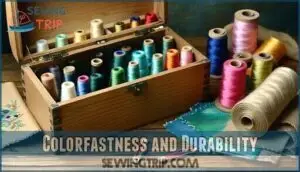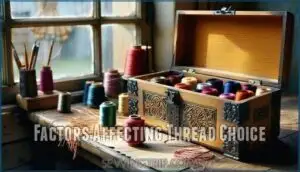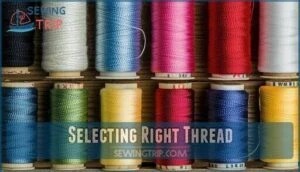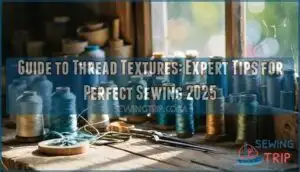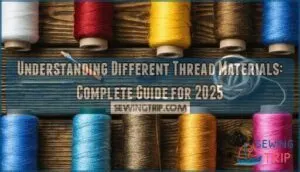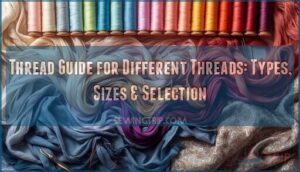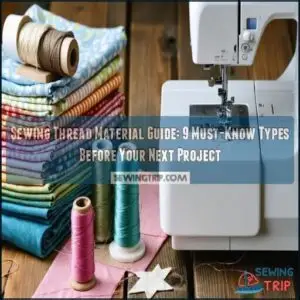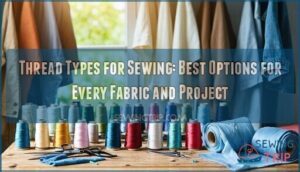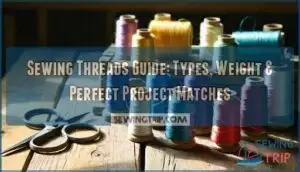This site is supported by our readers. We may earn a commission, at no cost to you, if you purchase through links.
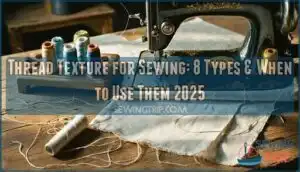
You’ll encounter smooth cotton threads that glide effortlessly through lightweight fabrics, lustrous silk that adds elegance to formal wear, and sturdy polyester that won’t break under tension.
Textured threads like wool create dimensional effects, while metallic threads catch light for decorative touches.
The key is matching thread texture to your fabric’s weight and weave—smooth threads work best with delicate materials, while rougher textures complement heavier fabrics.
Your thread choice affects everything from seam strength to how colors appear under different lighting conditions, and it’s crucial to select the right thread to achieve the desired look and durability, considering factors like the weight and weave of the fabric, as well as the overall aesthetic you want to achieve with dimensional effects and decorative touches.
Table Of Contents
- Key Takeaways
- Thread Types Overview
- Choosing Thread Weight
- Thread Material Selection
- Top 8 Thread Options
- 1. Embroidery Thread Floss Kit Supplies
- 2. Navy Blue Embroidery Thread Spool
- 3. Sewing Thread Kit Assortment Set
- 4. Polyester Serger Threads Cones Pack
- 5. Assorted Embroidery Thread Bobbins Set
- 6. Juki industrial sewing machine system
- 7. Brother Embroidery Machine Wireless Edition
- 8. Brother Sewing and Embroidery Machine
- Thread Texture Considerations
- Factors Affecting Thread Choice
- Selecting Right Thread
- Frequently Asked Questions (FAQs)
- Conclusion
Key Takeaways
- Match thread texture to fabric weight – You’ll get professional results when you pair smooth cotton threads with lightweight fabrics and sturdy polyester with heavier materials, like denim.
- Consider your project’s purpose – You should choose textured threads, like wool, for dimensional effects and metallic threads for decorative touches, while smooth threads work best for structural seams.
- Thread weight determines stitch appearance – You’ll need fine threads (60-80 weight) for delicate fabrics to prevent puckering, and heavier threads (30-40 weight) for durable seams on thick materials.
- Synthetic fibers offer superior durability – You can count on polyester threads for colorfastness and UV resistance in high-stress applications, while natural fibers, like cotton and silk, provide traditional appeal with less strength.
Thread Types Overview
You’ll find three main thread categories that shape your sewing experience: natural fibers like cotton and silk offer breathability and traditional appeal.
While synthetic options such as polyester deliver superior durability.
Blended threads combine the best of both worlds, giving you versatility for any project.
Natural Fibers
Natural fibers bring Mother Nature’s touch to your sewing projects, offering unique characteristics that synthetic alternatives can’t replicate.
Cotton’s absorbent nature creates matte textures with excellent durability, while wool’s crimped structure provides natural elasticity. Silk thread characteristics deliver unmatched luster and premium strength.
Here are key natural fiber benefits:
- Cotton Properties – Superior biodegradability and easy dyeing processes
- Wool Texture – Natural warmth retention with comfortable softness
- Silk Benefits – Beautiful sheen with exceptional thread strength
- Fiber Sourcing – Sustainable plant and animal origins
- Thread Fiber Types – Each offers distinct tactile qualities for specialized applications
Synthetic Fibers
Beyond cotton and wool, synthetic fibers revolutionize your sewing experience with unmatched durability.
Polyester thread leads with superior colorfastness and UV resistance, while nylon strength tackles heavy-duty projects effortlessly.
Acrylic softness mimics wool’s comfort without the bulk.
However, microfiber concerns about environmental impact grow.
Synthetic blends offer versatility, combining multiple benefits for demanding applications.
Blended Threads
Blended threads combine the best of both worlds, mixing natural and synthetic fibers to create hybrid threads that outperform their single-fiber counterparts.
These composite yarns offer balanced properties that pure fibers can’t match alone.
Key blended thread advantages:
- Cotton-polyester blends – Natural feel with synthetic durability
- Wool-acrylic mixtures – Warmth retention plus easy care
- Silk-nylon combinations – Luxurious sheen with added strength
- Rayon-polyester hybrids – Affordable luster with improved colorfastness
- Multi-fiber composites – Customized performance for specific applications
Thread texture varies dramatically based on blend ratios and fiber combinations.
Choosing Thread Weight
You’ll need to match thread weight to your fabric’s thickness and project demands for professional results.
Lighter fabrics require finer threads (60-80 weight), while heavy-duty materials like denim need thicker options (30-40 weight) that won’t snap under pressure.
Fabric Compatibility
When selecting thread weight, you’re basically matching your thread’s thickness to your fabric’s density.
Light fabrics like chiffon need fine threads (60-80 weight) to prevent puckering, while denim demands heavy-duty options (30-40 weight).
Fabric stretch determines sewing tension requirements—knits need flexible polyester threads that move with the material.
Fiber blends offer versatility, but texture matching remains vital for professional results.
To achieve superior sewing results, consider the thread selection guide for various fabric types.
Thread Durability
Thread Strength determines how well your seams hold up over time.
Polyester threads offer superior Wear Resistance compared to cotton, making them perfect for high-stress areas like pocket seams.
Fiber Blends combine strength with sewability – think polyester-wrapped cotton cores that resist thread breakage while maintaining smooth feeding.
Smart sewers test thread durability by tugging samples before starting projects.
Fray Prevention becomes critical when working with fabrics that see heavy use, so choose threads that match your fabric’s expected lifespan.
Understanding the right thread weight systems is vital for achieving maximum seam strength and durability.
Stitch Appearance
Your chosen thread weight dramatically shapes stitch appearance on fabric surfaces.
Fine threads create delicate, nearly invisible seams perfect for silk garments, while heavier weights produce bold topstitching that stands out.
Thread contrast against fabric color affects stitch visibility—matching hues blend seamlessly, contrasting ones make decorative statements.
The denier system helps predict how thread texture will interact with fabric drape, ensuring your seam quality enhances rather than compromises the finished piece’s overall texture blend.
Thread Material Selection
Selecting the right thread material transforms your sewing from amateur to professional-grade results.
You’ll discover how cotton‘s absorbent fibers create soft, breathable seams.
While polyester‘s synthetic strength handles heavy-duty projects that would snap natural threads.
Cotton Thread Properties
Every cotton thread brings unique cotton thread properties that make it a go-to choice for natural fiber projects.
Cotton absorbency allows it to wick moisture while maintaining thread softness against your skin.
You’ll find cotton texture creates that perfect matte finish for quilting and garment construction.
Natural durability guarantees your seams hold up through countless washes, though fiber strength won’t match synthetic alternatives for heavy-duty applications.
Understanding cotton fabric characteristics is essential for selecting the right thread for your sewing projects.
Silk Thread Characteristics
Behind every beautiful silk thread lies a story of remarkable fiber strength and luxurious appeal.
You’ll find silk thread delivers unmatched smoothness that glides through fabric like butter, making it perfect for delicate work.
Here’s what makes silk thread exceptional:
- Superior fiber strength – Natural protein fibers create incredible durability despite their delicate appearance
- Lustrous finish – Silk sheen adds elegant sophistication to any project, especially silk embroidery
- Smooth thread texture – Reduces friction and prevents snagging on delicate fabrics
- Natural silk durability – Maintains integrity through multiple washes when properly cared for
When working with silk threads, understanding silk sewing thread properties is essential for achieving professional results.
Polyester Thread Benefits
Four main polyester thread benefits make it your go-to choice for demanding projects.
Polyester strength outperforms cotton by resisting UV rays and heat damage. Thread durability stays consistent through countless wash cycles without fading.
Fiber blends enhance sewing performance while maintaining color vibrancy. Textile quality remains superior in high-stress applications like activewear and outdoor gear, where polyester strength and thread durability are crucial, and the fiber blends play a significant role.
Top 8 Thread Options
Choosing the right thread can make or break your sewing project, and with countless options available, you’ll want to know which ones actually deliver results.
We’ve tested and selected eight standout thread options that cover everything from delicate embroidery work to heavy-duty construction seams.
1. Embroidery Thread Floss Kit Supplies
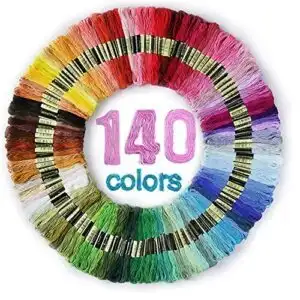
Embroidery floss kits bring together everything you need for colorful stitching projects.
The LOVIMAG premium rainbow kit delivers 140 vibrant colors in 100% cotton threads, each measuring 8.75 yards.
You’ll find six-stranded floss that separates easily for custom thickness control, and these extensive kits typically include bamboo hoops, needles, scissors, and organizing bobbins.
Machine-washable threads resist fading while maintaining their rich luster, whether you’re crafting friendship bracelets or detailed embroidery work, these versatile supplies handle multiple projects with professional results, making them ideal for various stitching tasks with colorful stitching projects.
Best For: Beginner to intermediate crafters who want extensive color variety and complete supplies for embroidery, cross-stitch, and friendship bracelet projects.
- Wide range of 140 vibrant colors with rich luster and fade-resistant properties for diverse project needs
- Complete kit includes essential accessories like hoops, needles, and organization tools for immediate use
- Six-stranded cotton threads separate easily for customizable thickness and professional-quality results
- No duplicate colors included, limiting options for large projects requiring multiple skeins of the same shade
- Some users report thread breakage when mishandled, requiring careful technique during use
- Material quality disputed by some users who identify it as synthetic blend rather than pure cotton
2. Navy Blue Embroidery Thread Spool
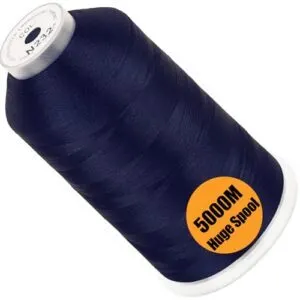
Why choose a navy blue embroidery thread spool when countless colors await?
This New brothread polyester spool delivers 5,500 yards of professional-grade 40wt thread that won’t let you down.
You’ll appreciate its exceptional colorfastness and lustrous finish that makes stitches pop against any fabric.
The 100% polyester construction handles high-speed embroidery machines beautifully, running at 800 stitches per minute without breaking.
Machine washable and fade-resistant, it’s perfect for everything from delicate silk to heavy-duty leather projects.
Best For: Home and professional embroiderers seeking reliable, high-quality thread for machine embroidery projects on various fabric weights.
- Artificial poly-rayon shine may not suit projects requiring natural thread appearance
- Some colors may have weaker strength due to extended dyeing processes
- Requires upright thread stand for proper feeding on home-based machines
- Exceptional durability with minimal breaking at high speeds (800 stitches per minute)
- Superior colorfastness and fade resistance through multiple washes
- Versatile compatibility with all major embroidery machine brands and fabric types
3. Sewing Thread Kit Assortment Set
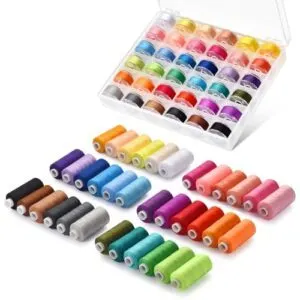
Combining convenience with versatility, sewing thread kit assortment sets deliver everything you’ll need in one organized package.
These sets typically include 36 polyester spools offering impressive color variety—from basic neutrals to vibrant hues that’ll match any fabric you’re working with.
The prewound bobbins save you precious setup time, while clear storage cases keep everything tidy and accessible.
You’ll appreciate the cost savings too, as kits often run 20-30% less than buying individual spools, making them perfect for beginners exploring different projects or experienced sewers stocking up efficiently.
Understanding the right thread weight considerations is essential for achieving professional-looking results with these thread kits, and you can find more information at thread weight considerations.
Best For: DIY enthusiasts, beginners, and experienced sewers looking for cost-effective color variety and convenient organization for general sewing, quilting, and embroidery projects.
- Thread spools lack a dedicated storage case, unlike the bobbins
- Some users report occasional thread accessibility issues and inconsistent thread amounts on spools
- May not be suitable for heavy-duty or specialty sewing applications requiring specific thread weights
- Cost savings of 20-30% compared to buying individual spools while providing 36 versatile colors
- Prewound bobbins and clear storage case offer excellent convenience and organization
- High-quality polyester thread that’s machine washable, strong, and compatible with most sewing machines
4. Polyester Serger Threads Cones Pack
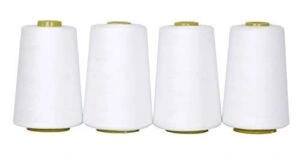
Polyester serger threads arrive on convenient cones that’ll make your overlocking projects sing.
These 40-weight, 2-ply workhorses deliver 6,000 yards per cone—enough thread to tackle serious sewing marathons without constantly switching spools.
You’ll appreciate their knot-free construction and minimal lint production, especially when your serger’s running at full throttle.
They’re tough enough for denim yet gentle on delicate fabrics, making them perfect for rolled hems and professional-grade seaming that won’t break under pressure.
Best For: Sewists and crafters who need reliable, high-capacity thread for serging, overlocking, and heavy-duty sewing projects on both commercial and home machines.
- Cone size may be too large for some smaller serger machines, requiring adapters for standard sewing machines
- Some users report inconsistent fill levels between spools and occasional lint buildup issues
- Shipping errors and quality control inconsistencies noted in customer feedback
- Large 6,000-yard cones provide excellent value and reduce thread changes during long sewing sessions
- Knot-free, low-lint construction works smoothly at high speeds without frequent breaks or machine jamming
- Versatile compatibility across fabric types from delicate lace to heavy denim and leather
5. Assorted Embroidery Thread Bobbins Set
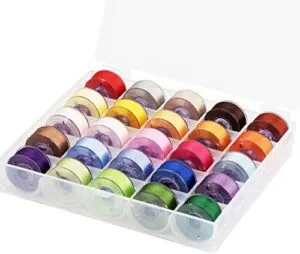
These twenty-five pre-wound bobbins pack a colorful punch for your embroidery adventures.
Each bobbin contains 140 yards of smooth 70D/2 polyester thread that won’t leave you hanging mid-stitch.
The random color assortment keeps things interesting—you might discover your new favorite shade.
At 60WT, they’re perfect for detailed work without overwhelming delicate fabrics.
Compatible with most home machines, they’ll save you time winding your own bobbins while delivering consistent tension throughout your project.
Best For: Hobbyists and small business owners who need convenient, ready-to-use bobbins for diverse embroidery projects without specific color requirements.
- Random color assortment means you can’t choose specific shades for planned projects
- Thread strength may not match premium brands for heavy-duty or commercial applications
- Some bobbins may arrive unwound, requiring rewinding before use
- Pre-wound design saves time and ensures consistent tension for professional-looking results
- Excellent value with 140 yards per bobbin and compatibility across major sewing machine brands
- Convenient storage box keeps colors organized and prevents tangling
6. Juki industrial sewing machine system
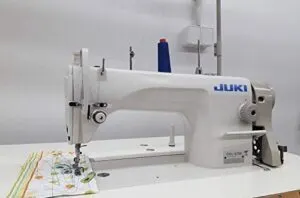
Industrial powerhouses demand threads that won’t quit under pressure.
You’ll find Juki systems handle thread weights from Tex 70 to 90, accommodating everything from delicate silk to heavy denim with their DBx1 needle system.
These machines stitch at 5,500 stitches per minute while maintaining precise tension control through dual adjustment dials.
The robust die-cast aluminum frame won’t buckle during marathon sewing sessions, making it perfect for professional workshops where thread performance matters most.
Best For: Professional sewers, manufacturers, and workshop owners who need high-speed, heavy-duty stitching for demanding materials like leather, denim, and upholstery fabrics.
- Exceptional speed at 5,500 stitches per minute with precise tension control for consistent professional results
- Robust die-cast aluminum construction handles intensive daily use without compromising stitch quality
- Versatile thread compatibility (Tex 70-90) and DBx1 needle system accommodates wide range of materials from silk to heavy denim
- Assembly issues reported including unclear instructions, missing parts, and manufacturing defects on tables
- Poor customer service from some distributors with unfulfilled promises for corrections and refunds
- Initial setup complexity often requires YouTube videos for proper assembly guidance
7. Brother Embroidery Machine Wireless Edition
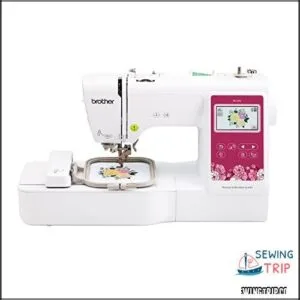
With wireless connectivity at your fingertips, this embroidery machine transforms how you’ll approach threading projects.
The 4" x 4" field handles delicate work perfectly, while 135 built-in designs give you creative freedom without hunting for patterns.
You’ll love the drag-and-drop touchscreen that makes positioning effortless, and standard 40wt polyester and rayon threads work beautifully here, creating professional results on small patches and personalization projects.
Though it won’t tackle large quilts, it’s your reliable partner for precise, detailed embroidery work, making it ideal for personalization projects.
Best For: Beginners and hobbyists looking for an easy-to-use embroidery machine for small, detailed projects like patches, logos, and personalization work.
- Wireless connectivity and mobile app integration streamline design transfer and workflow
- User-friendly touchscreen with drag-and-drop positioning makes operation simple for beginners
- Quiet operation with reliable automatic thread cutting and tension control for professional results
- Limited 4" x 4" embroidery field restricts projects to small designs only
- Embroidery-only functionality means it can’t handle regular sewing tasks
- Some users report occasional mechanical issues and connectivity problems requiring troubleshooting
8. Brother Sewing and Embroidery Machine
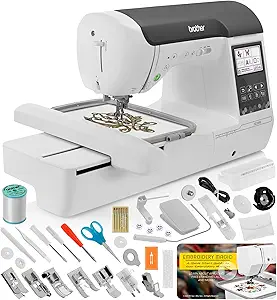
The Brother Sewing and Embroidery Machine delivers professional-grade versatility with 241 built-in sewing stitches and 193 embroidery designs.
You’ll appreciate the 5"x7" embroidery field, automatic needle threading, and wireless connectivity for seamless design transfers.
Its seven-piece feed dog system handles everything from delicate silks to heavyweight denim with confidence, while the machine’s quiet operation won’t wake the neighbors during late-night crafting sessions.
Automatic jump stitch trimming keeps your workflow smooth, and the machine is compatible with polyester, cotton, and specialty threads, making it your reliable partner for both everyday mending and intricate embroidery projects.
Best For: Crafters and sewers who want a versatile machine that handles both everyday sewing projects and embroidery work without breaking the bank.
- Combines 241 sewing stitches with 193 embroidery designs in one machine, eliminating the need for separate equipment
- Automatic features like needle threading and jump stitch trimming streamline workflow and reduce manual setup time
- Wireless connectivity and app compatibility make it easy to import custom designs and expand creative possibilities
- 5"x7" embroidery field may feel limiting for larger projects compared to dedicated embroidery machines
- Threading mechanism requires the machine to be powered on, which can be inconvenient for basic setup tasks
- Entry-level embroidery speed of 850 SPM is slower than professional-grade machines for high-volume work
Thread Texture Considerations
Thread texture plays a critical role in determining how your finished project looks and performs, affecting everything from seam strength to visual appeal.
Understanding how fabric characteristics interact with different thread textures helps you make informed choices that enhance both durability and appearance.
Fabric Stretch and Texture
When matching thread fiber types to fabric texture, you’re basically creating a partnership between materials.
The thread texture must complement your fabric’s unique characteristics to prevent puckering, breaking, or poor seam quality.
Consider these key factors for ideal thread-fabric compatibility:
- Fabric elasticity requires threads with similar stretch properties to maintain seam integrity
- Weave density affects thread count selection – tighter weaves need finer threads
- Fiber blends in fabrics should guide your thread texture analysis for best results.
Your fabric stretch determines thread performance more than you’d think.
Thread Luster and Sheen
Beyond fabric weight, thread luster and sheen dramatically affect your project’s final appearance.
Silk sheen creates luxurious finishes that catch light beautifully, while matte cotton provides subtle, professional results.
High-gloss rayon thread makes decorative stitching pop, and medium-luster polyester offers versatility.
Match thread shine to your fabric finish—glossy threads enhance satin, while low-sheen options complement natural textures perfectly.
Colorfastness and Durability
Your thread’s fade resistance determines whether your project will look crisp after multiple washes or fade like yesterday’s jeans.
Color retention and dye stability vary dramatically between fiber types, affecting thread longevity and durability.
- Polyester threads maintain vibrant colors through countless wash cycles
- Cotton threads may soften in color but offer natural charm
- Silk threads retain luster while gradually mellowing with age
- Rayon threads show poor colorfastness and require gentle handling
- UV-resistant threads prevent sun damage in outdoor applications
Factors Affecting Thread Choice
Your thread choice determines whether your project holds up to daily wear or falls apart at the seams.
Three key factors—project type, environmental conditions, and thread quality—shape this critical decision and directly impact your sewing success.
Project Type and Fabric Compatibility
Your project type directly influences fabric choice and thread matching decisions.
Quilting cotton requires different material selection than stretchy activewear or heavy canvas bags.
Project planning starts with understanding your fabric type—lightweight silks need fine threads, while denim demands heavy-duty options.
Sewing techniques also matter: topstitching showcases thread texture, while hidden seams prioritize fabric compatibility over appearance.
Environmental Factors and Care
Heat whispers destruction to your favorite threads, while humidity plays havoc with fiber stability.
You’ll find biodegradable threads like cotton and silk vulnerable to moisture swings, unlike resilient polyester.
Sustainable sewing demands smart storage—cool, dry spaces protect eco-friendly materials from UV damage.
Green materials require extra care, but proper environmental control extends thread durability while supporting waste reduction goals and promoting sustainable practices.
Thread Quality and Performance
Quality standards separate professional results from amateur attempts.
Professional threads demand professional choices – your project’s strength starts with thread quality.
Your fabric durability depends heavily on thread strength and yarn construction choices. High-performance fiber blends deliver consistent sewing performance across demanding projects.
Consider these thread quality markers:
- Thread strength – Polyester outperforms cotton in stress tests
- Yarn construction – Core-spun threads combine strength with softness
- Fiber consistency – Even thread texture prevents tension issues
- Performance reliability – Quality threads maintain durability through washing cycles
The right thread selection process is vital for achieving superior sewing results.
Selecting Right Thread
You’ll achieve professional results when you match your thread choice to your fabric’s specific needs and project requirements.
Consider fabric weight, thread strength, and color compatibility to guarantee your seams appear polished and withstand regular use.
Considering Fabric Type and Weight
Matching fabric weight to thread thickness creates seamless results.
Delicate chiffon demands fine 60-weight threads, while denim requires robust 30-weight options.
This thread compatibility prevents puckering and guarantees proper sewing performance.
| Fabric Type | Thread Weight | Material Selection |
|---|---|---|
| Lightweight silks, chiffon | 60-80 weight | Fine polyester, silk |
| Medium cottons, linens | 40-50 weight | Cotton, poly-cotton blend |
| Heavy denim, canvas | 30-40 weight | Heavy-duty polyester |
| Stretch knits, spandex | 40 weight | Polyester, woolly nylon |
| Upholstery fabrics | 20-30 weight | Bonded nylon, polyester |
Texture matching goes beyond weight—consider your fabric’s surface.
Smooth satins pair beautifully with lustrous threads, while matte cottons work best with low-sheen options.
Thread fiber content affects the overall strength and stretch.
Fabric texture compatibility affects how stitches settle and how seams behave over time.
Thread fiber content is a crucial factor in achieving the desired outcome.
Evaluating Thread Strength and Durability
You’ll want to check thread tensile strength before starting any serious project.
Polyester threads typically handle 2,000-6,000cN breaking force, while cotton manages less.
Test your thread’s durability by giving it a firm tug—quality threads resist snapping.
Core-spun construction beats regular spun threads every time.
Synthetic materials offer superior material resistance and fiber longevity compared to natural options for demanding sewing performance applications.
Understanding thread strength ratings is essential for selecting the right thread for your project, and you can find more information at strength ratings.
Matching Thread Color and Sheen to Fabric
Perfect thread color and sheen combinations make or break your project’s polished appearance.
Color matching should align closely with your fabric’s dominant hues, while thread sheen must complement fabric texture types.
Matte cotton fabrics pair beautifully with low-luster threads, whereas silk demands lustrous options.
Consider dye compatibility and colorfastness when selecting thread color options – mismatched thread finish creates amateur results that scream "homemade mistake.
Frequently Asked Questions (FAQs)
What thread should I use for a sewing project?
Like choosing the right tool for the job, you’ll match thread weight to fabric weight for best results.
Select 50-weight polyester for medium fabrics, cotton for quilting, or silk for delicates.
How do I choose the best sewing thread?
Consider your fabric’s weight and stretch first.
Match thread weight to fabric thickness—finer threads for delicate materials, heavier for denim.
Choose polyester for durability, cotton for natural fibers, and make certain colors complement your project’s finish.
What are sewing threads?
Sewing threads are twisted strands of natural or synthetic fibers that bind fabric pieces together.
You’ll find cotton, polyester, silk, and nylon varieties, each offering different strengths, stretch, and finishes for your projects, with polyester being a common choice.
What is textured thread?
Imagine a thread so lively, it feels like a tiny spring in your fingertips.
Textured thread’s crimped or looped fibers boost elasticity and bulk, making your seams stretchier, softer, and perfect for knits or activewear.
What is a good thread for a sewing machine?
Polyester thread works best for most sewing machines.
You’ll get consistent stitches, excellent color retention, and minimal breakage.
It handles various fabrics well and won’t shrink or fade like cotton options sometimes do, providing excellent results.
How do I choose a thread for sewing a silk fabric?
Choose silk or fine polyester thread in 50-60 weight for silk fabric.
Match the thread’s sheen to your silk’s finish.
Fine threads won’t overpower delicate silk fibers, ensuring smooth stitches and professional results.
What does Tex 27 mean in thread?
Remarkably, tex systems measure thread weight using metric units that originated in industrial manufacturing.
Tex 27 means you’re working with thread that weighs 27 grams per 1,000 meters—that’s medium-weight thread perfect for general sewing.
What is a textured thread?
Textured thread features a deliberately rough, bumpy surface created through special processing techniques.
You’ll find it grips fabric better than smooth threads, making it perfect for decorative stitching and specialty applications where enhanced texture adds visual interest.
Which thread is thicker, 30 or 40?
Like choosing between heavyweight and welterweight boxers, 30 weight thread packs more punch than 40 weight.
Remember: lower numbers mean thicker threads.
You’ll feel 30’s substantial heft compared to 40’s lighter touch when handling them.
How does thread twist direction affect seams?
Thread twist direction determines how your seams behave under stress.
Right-twist thread (S-twist) works best with most sewing machines, while left-twist (Z-twist) can cause tension issues and weaker seams that unravel more easily during wear.
Conclusion
Like threads woven into fabric’s tapestry, your choice of thread texture for sewing becomes the invisible foundation that determines your project’s success.
You’ve learned how cotton’s smoothness complements delicate fabrics, while polyester’s strength handles heavy-duty tasks.
Silk adds luxury, metallic creates sparkle, and textured options provide dimension.
Remember—matching thread texture for sewing to your fabric’s weight and purpose isn’t just technical knowledge, it’s your secret weapon for professional-looking results every time, with the right choice of thread being a key factor in achieving delicate fabrics and handling heavy-duty tasks.
- https://www.mhthread.com/blog/products/what-thread-is-best-for-sewing
- https://www.youtube.com/watch?v=yX236z0VYDE
- https://www.amefird.com/technical-tools/thread-education/thread-science/
- https://www.reddit.com/r/sewing/comments/wugjwd/does_thread_quality_affect_tension_or_cause/
- https://www.allfreesewing.com/Sewing-Tips-and-Tricks/What-Types-of-Thread-to-Use-A-Guide

